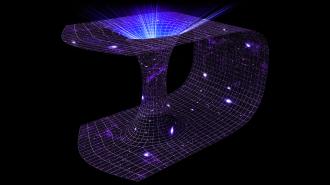Albert Einstein is rightfully considered one of the most impactful physicists of all times. He created his various theories of relativity, which govern the behavior of matter moving at tremendous speeds and reimagined the force of gravity as the bending of space and time. He also wrote prodigiously on the idiosyncrasies of quantum mechanics, rejecting it as being fundamentally incorrect, yet exploring the implications of the theory.
While Einstein’s reputation as a genius is secure, a little extra validation never hurts, especially when it revolves around one of Einstein’s most exotic predictions: wormholes, or tunnels through space.
A consortium of researchers from Caltech, Google, Fermilab, MIT, and Harvard used a device called the Sycamore quantum processor to generate and control what is equivalent to a wormhole. (The Sycamore is a quantum computer developed by Google.) How does this work? It comes down to intricate interconnections between two of Einstein’s ideas.
Wormholes and quantum entanglement
In 1935, Einstein was working with his student Nathan Rosen on ways to convert his theory of gravity, called the theory of general relativity, into a theory of everything. One problem was that the theory predicted infinities at the center of black holes. These infinities arose when the total mass of a dead star collapsed down into a spot of zero size, what are called singularities.
Rosen and Einstein played around with other possible solutions, including using some creative mathematics to replace two singularities with a tube that connected them. These tubes are called Einstein-Rosen bridges or, more colloquially, wormholes. In principle, it would be possible to have an object enter one wormhole and exit the other, even though the ends of the wormholes are separated by large distances. The object would have traveled through extra dimensions. This work is called ER theory.
Wormholes are favorites of science fiction writers, as they provide the possibility of faster-than-light travel. Spacecraft could travel large distances in zero time. While there are many practical problems involved with making wormholes, an especially important one is that they are unstable unless stabilized by large amounts of negative energy.
That same year, Einstein and Rosen also worked on a topic in quantum mechanics, this time with another physicist by the name of Boris Podolsky. This topic involved quantum entanglement, which considers the behavior of two objects that were initially in contact with one another so that their properties are intertwined. While the properties of neither object were determined — that’s part of the craziness of quantum mechanics — the fact that they were the opposite of one another is “baked in” at the outset.
The tricky business was that even if you separated the two objects by enormous distances and measured the properties of one of them, you instantly knew the properties of the other, despite the properties of neither being determined until a measurement was performed. This was called the EPR paradox, after the researchers’ initials.
ER = EPR
Both the ER theory and EPR paradox were considered curiosities for a long time, however it was in the last decade when scientists began to understand that the two ideas had deeper connections. In fact, it has become clear that the two ideas are, in many ways, functionally identical. Two physicists, Juan Maldacena and Leonard Susskind, are often mentioned as having made some of the more crucial contributions to this realization, and it was Maldacena who coined the succinct representation of the observation: “ER = EPR.”
If it is indeed true that ER = EPR, then we are in luck, because, while we cannot create and generate wormholes, we certainly can do EPR measurements. We have done measurements like that for decades.
Wormholes might be real
This is where the new announcement enters the picture. In a paper in Nature, researchers developed a simplified approach to the problem and modeled wormhole behavior on the quantum computer. They found that the result was exactly as expected. They were even able to simulate conditions whereby the theoretical wormhole was governed by positive and negative energy and discovered that, while the positive option was unstable, the negative one was stable — just as ER theory suggests.
To the extent that EPR and ER are mathematically the same, this work implies that wormholes are not just theoretical curiosities.
It is important to note that the researchers did not generate a physical wormhole. No objects were transferred through extra dimensions. Instead, what was demonstrated was quantum behavior. However, since the mathematics of ER and EPR are deeply intertwined, the new result suggests that wormholes are at least a possibility.
Quantum gravity
The deeper implications of this work are that it provides researchers with a laboratory to explore not only ER theory and the EPR paradox but also a theory called quantum gravity, which is the extension of gravity to the world of the super small. A successful theory of quantum gravity has eluded the scientific community for nearly a century, so this new capability may help illuminate a path forward. Indeed, quantum computing has provided the capacity to test ideas that were impossible just a few years ago.
This article was reprinted with permission of Big Think, where it was originally published.





